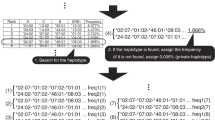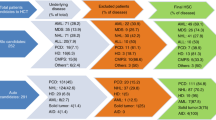Abstract
The MHC region on chromosome 6 contains a large number of non-HLA genes next to the HLA genes. Matching for HLA in unrelated hematopoietic SCT (HSCT) does not necessarily mean that these non-HLA genes are also matched. We selected 348 Northwest European patients transplanted with an HLA-A-, -B-, -C-, -DRB1-, -DQB1-matched unrelated donor (MUD) between 1987 and 2008. Patients’ haplotypes were identified via descend. We were unable to determine the haplotypes of the donor; therefore we used frequent haplotypes (FH) in high linkage disequilibrium (LD) as a proxy for haplotype matching. Presence of a FH in a patient positively affected the probability and speed of identifying a matched unrelated donor. Competing risk survival analysis showed that patients with one or two FH have a statistically significantly decreased probability of developing ⩾grade II acute GVDH (aGVHD) without increased risk of relapse compared to patients without FH (HR (95% CI): 0.53 (0.31–0.91)). This association was strongest for those FH with the highest LD between both HLA-A and -C or –B, and HLA-C or –B and -DRB1 (HR (95% CI): 0.49 (0.26–0.92)). These results extend evidence that non-HLA allele coding regions have a significant impact on development of ⩾grade II aGVHD. We conclude that there is more to successful HSCT than matching for HLA genes.
This is a preview of subscription content, access via your institution
Access options
Subscribe to this journal
Receive 12 print issues and online access
$259.00 per year
only $21.58 per issue
Buy this article
- Purchase on Springer Link
- Instant access to full article PDF
Prices may be subject to local taxes which are calculated during checkout



Similar content being viewed by others
References
Flomenberg N, Baxter-Lowe LA, Confer D, Fernandez-Vina M, Filipovich A, Horowitz M et al. Impact of HLA class I and class II high-resolution matching on outcomes of unrelated donor bone marrow transplantation: HLA-C mismatching is associated with a strong adverse effect on transplantation outcome. Blood 2004; 104: 1923–1930.
MHC sequencing consortium. Complete sequence and gene map of a human major histocompatibility complexThe MHC sequencing consortium. Nature 1999; 401: 921–923.
Tay GK, Witt CS, Christiansen FT, Charron D, Baker D, Herrmann R et al. Matching for MHC haplotypes results in improved survival following unrelated bone marrow transplantation. Bone Marrow Transplant 1995; 15: 381–385.
Petersdorf EW, Malkki M, Gooley TA, Martin PJ, Guo Z . MHC haplotype matching for unrelated hematopoietic cell transplantation. PLoS Med 2007; 4: e8.
Morishima S, Ogawa S, Matsubara A, Kawase T, Nannya Y, Kashiwase K et al. Impact of highly conserved HLA haplotype on acute graft-versus-host disease. Blood 2010; 115: 4664–4670.
Dickinson AM . Non-HLA genetics and predicting outcome in HSCT. Int J Immunogenet 2008; 35: 375–380.
Mullally A, Ritz J . Beyond HLA: the significance of genomic variation for allogeneic hematopoietic stem cell transplantation. Blood 2007; 109: 1355–1362.
Mullighan CG, Bardy PG . New directions in the genomics of allogeneic hematopoietic stem cell transplantation. Biol Blood Marrow Transplant 2007; 13: 127–144.
Trowsdale J . HLA genomics in the third millennium. Curr Opin Immunol 2005; 17: 498–504.
Choy MK, Phipps ME . MICA polymorphism: biology and importance in immunity and disease. Trends Mol Med 2010; 16: 97–106.
Ishikawa Y, Kashiwase K, Akaza T, Morishima Y, Inoko H, Sasazuki T et al. Polymorphisms in TNFA and TNFR2 affect outcome of unrelated bone marrow transplantation. Bone Marrow Transplant 2002; 29: 569–575.
Keen LJ, DeFor TE, Bidwell JL, Davies SM, Bradley BA, Hows JM . Interleukin-10 and tumor necrosis factor alpha region haplotypes predict transplant-related mortality after unrelated donor stem cell transplantation. Blood 2004; 103: 3599–3602.
Shaw BE, Maldonado H, Madrigal JA, Smith C, Petronzelli F, Mayor NP et al. Polymorphisms in the TNFA gene promoter region show evidence of strong linkage disequilibrium with HLA and are associated with delayed neutrophil engraftment in unrelated donor hematopoietic stem cell transplantation. Tissue Antigen 2004; 63: 401–411.
Viel DO, Tsuneto LT, Sossai CR, Lieber SR, Marques SB, Vigorito AC et al. IL2 and TNFA gene polymorphisms and the risk of graft-versus-host disease after allogeneic haematopoietic stem cell transplantation. Scand J Immunol 2007; 66: 703–710.
Parmar S, Del LM, Zou Y, Patah PA, Liu P, Cano P et al. Donor-recipient mismatches in MHC class I chain-related gene A in unrelated donor transplantation lead to increased incidence of acute graft-versus-host disease. Blood 2009; 114: 2884–2887.
Malkki M, Gooley T, Horowitz M, Petersdorf EW . MHC class I, II, and III microsatellite marker matching and survival in unrelated donor hematopoietic cell transplantation. Tissue Antigen 2007; 69 (Suppl 1): 46–49.
Bettens F, Passweg J, Schanz U, Chalandon Y, Heim D, Gungor T et al. Impact of HLA-DPB1 haplotypes on outcome of 10/10 matched unrelated hematopoietic stem cell donor transplants depends on MHC-linked microsatellite polymorphisms. Biol Blood Marrow Transplant 2011; 18: 608–616.
Dorak MT, Shao W, Machulla HK, Lobashevsky ES, Tang J, Park MH et al. Conserved extended haplotypes of the major histocompatibility complex: further characterization. Genes Immun 2006; 7: 450–467.
Malkki M, Single R, Carrington M, Thomson G, Petersdorf E . MHC microsatellite diversity and linkage disequilibrium among common HLA-A, HLA-B, DRB1 haplotypes: implications for unrelated donor hematopoietic transplantation and disease association studies. Tissue Antigen 2005; 66: 114–124.
Petersdorf EW, Shuler KB, Longton GM, Spies T, Hansen JA . Population study of allelic diversity in the human MHC class I-related MIC-A gene. Immunogenetics 1999; 49: 605–612.
Witt C, Moghaddam PH, van der MR, Trimboli F, Ottinger H, Christiansen F et al. Matching for TNF microsatellites is strongly associated with matching for other non-HLA MHC sequences in unrelated bone marrow donor-recipient pairs. Hum Immunol 1999; 60: 862–866.
Oudshoorn M, Cornelissen JJ, Fibbe WE, de Graeff-Meeder ER, Lie JL, Schreuder GM et al. Problems and possible solutions in finding an unrelated bone marrow donor. Results of consecutive searches for 240 Dutch patients. Bone Marrow Transplant 1997; 20: 1011–1017.
Pedron B, Duval M, Elbou OM, Moskwa M, Jambou M, Vilmer E et al. Common genomic HLA haplotypes contributing to successful donor search in unrelated hematopoietic transplantation. Bone Marrow Transplant 2003; 31: 423–427.
Pedron B, Yakouben K, Adjaoud D, Auvrignon A, Landman J, Guerin V et al. Listing of common HLA alleles and haplotypes based on the study of 356 families residing in the Paris, France, area: implications for unrelated hematopoietic stem cell donor selection. Hum Immunol 2005; 66: 721–731.
Pedron B, Guerin-El KV, Dalle JH, Ouachee-Chardin M, Yakouben K, Corroyez F et al. Contribution of HLA-A/B/C/DRB1/DQB1 Common Haplotypes to Donor Search Outcome in Unrelated Hematopoietic Stem Cell Transplantation. Biol Blood Marrow Transplant 2011; 17: 1612–1618.
Tiercy JM, Bujan-Lose M, Chapuis B, Gratwohl A, Gmur J, Seger R et al. Bone marrow transplantation with unrelated donors: what is the probability of identifying an HLA-A/B/Cw/DRB1/B3/B5/DQB1-matched donor? Bone Marrow Transplant 2000; 26: 437–441.
Tiercy JM, Nicoloso G, Passweg J, Schanz U, Seger R, Chalandon Y et al. The probability of identifying a 10/10 HLA allele-matched unrelated donor is highly predictable. Bone Marrow Transplant 2007; 40: 515–522.
Tron de BE, Leberre C, Dauriac C, Genetet N, Lapart C, Fauchet R et al. Relevance of 10 Caucasian HLA haplotypes in searches for unrelated bone marrow donors for 100 patients from a single center. Bone Marrow Transplant 1995; 15: 845–851.
Heemskerk MB, van Walraven SM, Cornelissen JJ, Barge RM, Bredius RG, Egeler RM et al. How to improve the search for an unrelated haematopoietic stem cell donor. Faster is better than more!. Bone Marrow Transplant 2005; 35: 645–652.
Excoffier L, Slatkin M . Maximum-likelihood estimation of molecular haplotype frequencies in a diploid population. Mol Biol Evol 1995; 12: 921–927.
Lewontin RC, Kojima K . The evolutionary dynamics of complex polymorphisms. Evolution 1960; 14: 458–472.
Lancaster AK, Single RM, Solberg OD, Nelson MP, Thomson G . PyPop update--a software pipeline for large-scale multilocus population genomics. Tissue Antigen 2007; 69 (Suppl 1): 192–197.
Fine JP, Gray RJA . Proportional Hazards Model for the Subdistribution of a Competing Risk. J Am Stat Assoc 1999; 94: 496–509.
Schipper RF, D’Amaro J, Bakker JT, Bakker J, van Rood JJ, Oudshoorn MHLA . gene haplotype frequencies in bone marrow donors worldwide registries. Hum Immunol 1997; 52: 54–71.
Pallua S, Giesinger J, Oberguggenberger A, Kemmler G, Nachbaur D, Clausen J et al. Impact of GvHD on quality of life in long-term survivors of haematopoietic transplantation. Bone Marrow Transplant 2010; 45: 1534–1539.
Svahn BM, Remberger M, Alvin O, Karlsson H, Ringden O . Increased costs after allogeneic haematopoietic SCT are associated with major complications and re-transplantation. Bone Marrow Transplant 2011; 47: 706–715.
Roopenian D, Choi EY, Brown A . The immunogenomics of minor histocompatibility antigens. Immunol Rev 2002; 190: 86–94.
Battiwalla M, Hahn T, Radovic M, Roy H, Wahab A, Duman E et al. Human leukocyte antigen (HLA) DR15 is associated with reduced incidence of acute GVHD in HLA-matched allogeneic transplantation but does not impact chronic GVHD incidence. Blood 2006; 107: 1970–1973.
Kollman C, Howe CW, Anasetti C, Antin JH, Davies SM, Filipovich AH et al. Donor characteristics as risk factors in recipients after transplantation of bone marrow from unrelated donors: the effect of donor age. Blood 2001; 98: 2043–2051.
Eapen M, Rocha V, Sanz G, Scaradavou A, Zhang MJ, Arcese W et al. Effect of graft source on unrelated donor haemopoietic stem-cell transplantation in adults with acute leukaemia: a retrospective analysis. Lancet Oncol 2010; 11: 653–660.
Shaw BE, Gooley TA, Malkki M, Madrigal JA, Begovich AB, Horowitz MM et al. The importance of HLA-DPB1 in unrelated donor hematopoietic cell transplantation. Blood 2007; 110: 4560–4566.
Acknowledgements
We would like to thank the search coordinators at the Europdonor Foundation who performed all UD searches and the employees of the section of Immunogenetics and Transplantation Immunology of the LUMC for HLA typing of all donors and patients.
Author information
Authors and Affiliations
Corresponding author
Ethics declarations
Competing interests
The authors declare no conflict of interest.
Rights and permissions
About this article
Cite this article
Jöris, M., Lankester, A., Borne, P. et al. The impact of frequent HLA haplotypes in high linkage disequilibrium on donor search and clinical outcome after unrelated haematopoietic SCT. Bone Marrow Transplant 48, 483–490 (2013). https://doi.org/10.1038/bmt.2012.189
Received:
Revised:
Accepted:
Published:
Issue Date:
DOI: https://doi.org/10.1038/bmt.2012.189
Keywords
This article is cited by
-
High-resolution HLA phased haplotype frequencies to predict the success of unrelated donor searches and clinical outcome following hematopoietic stem cell transplantation
Bone Marrow Transplantation (2019)
-
Spousal hematopoietic stem cell transplantation
International Journal of Hematology (2017)
-
Unrelated donor search prognostic score to support early HLA consultation and clinical decisions
Bone Marrow Transplantation (2016)
-
Haplotyping the human leukocyte antigen system from single chromosomes
Scientific Reports (2016)
-
Determination of HLA-A, -B, and -DRB1 Allele and Haplotype Frequencies in the Croatian Population Based on a Family Study
Archivum Immunologiae et Therapiae Experimentalis (2016)



